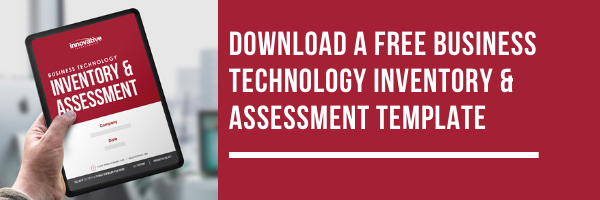Alternatives to a Server in Your Business
Alternatives to a business server:
- Workgroup Sharing
- Network Attached Storage (NAS) Device
- Microsoft 365 (formerly Office 365)
- Cloud Hosted Server (think Microsoft Azure or AWS)
- File Sync and Share Applications (think Drop Box, Google Docs)
A server allows businesses to point all users toward a centralized location to access files and applications. There are some considerations when deciding if your business needs a server. In general, servers offer many benefits, and are a common approach for businesses that want consistency, centralization, or compliance with PCI, HIPAA or other industry-specific requirements.
If you're not sure that a server environment is right for your business, there are other alternatives to consider, each with their own pros and cons.
Want Exclusive Content Like This?
Sign up for our monthly email.
1. Workgroup Sharing
If you have multiple computers on the same network then workgroup sharing can be utilized to accomplish file sharing between your users. This solution provides for some basic file centralization in situations where it is difficult to justify the upfront server cost.
Pros: Within the Windows desktop operating system, you can allow other computers to connect into one “master” system for file sharing. Separate directories can be created to properly organize data, and security can even be tied to these systems to prevent unwanted access.
Cons: Some of the common pitfalls with this strategy revolve around managing the access and security to this data. User accounts need to be created and maintained on every computer in the office to facilitate the necessary file access and security. If you have 10 users, those 10 accounts need to be setup on the “master” system.
Password changes on the master computer could wreak havoc on others tied into the sharing. Many businesses choose not to update passwords because of this but just imagine the security vulnerability you face when passwords are not changing!
You also deal with up-time limitations since PC’s are not designed for 100% up-time like a server is.
2. Network Attached Storage (NAS) Device
Have you ever heard of a NAS (Network Attached Storage)? These come in all shapes and sizes, typically have a very small physical footprint and are designed to store and share data. A NAS is very similar to the workgroup sharing model except that it doesn’t require someone's computer to manage the data and user accounts.
Pros: A NAS can come in small sizes and grow to multiple terabytes of data. Some devices even include off-site synchronization of your data in case of hardware failure. Data is stored and organized on these external devices that connect to your network via a wired or wireless connection.
User accounts are created through a web interface that is available to manage the device. Microsoft Windows computers can be pointed to this device for users to access the data. Sometimes these devices even come with apps used to access the data from off-site.
Cons: While these devices are designed for more up-time than a typical PC, they possess very similar issues as workgroup sharing (access and security).
Password changes still wreak havoc, users will lose their connection to the NAS from time to time and the device is typically stored in a closet somewhere where it can't be seen. Also, as hardware failures occur, users may not notice any blinking lights indicating failure until the physical device becomes unavailable. At least with a computer, you tend to know when something is going wrong.
3. Microsoft 365 (Formerly Office 365)
Microsoft 365 (formerly called Office 365) is an integrated experience of apps and services designed to help grow businesses. It comes in MANY different flavors but within this suite lies a way to alleviate the need for a server.
Pros: If you are a small business, one monthly subscription can allow you to do the following:
- Host your email (Microsoft Exchange).
- Have the latest version of the Microsoft Office suite (Outlook, Word, Excel, Powerpoint).
- Share data with your employees (Microsoft Teams)
In recent months, Microsoft has also been pushing its new collaboration service called Teams. This service allows businesses to very easily create teams/groups for different areas of their business and store data, collaborate with others and even share the data with external users.
There is also embedded chat (Formerly Skype for Business) so that you can effectively communicate with members of your business. With Teams you can very easily edit files TOGETHER through typical Microsoft Office tools your business is already familiar with. You can also utilize the Microsoft Office web versions to access the data if you are not in front of your computer or tablet.
Cons: While this is a very attractive option, your data is fully stored in the cloud, which can be a scary option. Microsoft takes great pains to ensure the data is protected and available, but if Microsoft’s data centers are offline, your information is not accessible. Your data is also not accessible if your internet is down.
Finally, you don’t have many protections if data is deleted. Basic recovery is available through Microsoft's interface but don’t expect to receive help from them if a file needs to be restored.
4. Cloud Hosted Server
Sometimes businesses really do need the benefits of a server but replacing hardware every 5 years isn't a feasible option. A recent alternative to this situation is a hosted server. The basic premise of server hosting is that a company such as Microsoft or Amazon will virtually give you a server that they manage and keep running. It is accessed over a secure tunnel from your place of business and behaves like a typical server.
Pros: You receive all the benefits of an on-premise server without the upfront cost of hardware (or noisy equipment in the IT closet).
A modest monthly fee per server is typically the trade off for a service such as this. Some models bill based on server usage (How much data your staff is accessing) to try and keep costs down. Other models bill a flat monthly fee for your hosted server.
Cons: This can be a good option for some businesses, but it is not uncommon that your yearly costs add up to the cost of a server when looking at a typical 5-year investment.
A fast internet connection is a must with this option or you will have a lot of frustrated users. I would even recommend having a backup internet connection installed since your internet will now be critical to your basic file access.
5. File Sync and Share Applications
The final alternative is tools classified as file sync and share applications. You have probably heard of these tools before (Drop Box, Microsoft One Drive, Google Drive, etc.). These applications are designed to take data saved on your computer and synchronize it to the cloud. Other users in your office will also have these tools installed on their computers to keep your data continually synchronized locally and offsite.
Pros: Mobile users really benefit from a solution like this because they don’t need to be in the office to access data stored on a workstation or NAS.
When a file is edited and saved, the application detects the change and re-synchronizes to the cloud. Other users who have access to the folder where this data lives receive the latest version of the file and can also be alerted when it changes.
Cons: This solution is a nice hybrid option that allows your data to be accessed locally and in the cloud. The crux of this solution lies in the agent running on each computer. If the software agent stops working (or gets uninstalled somehow), you will be left with multiple copies of data on each machine that may or may not be updating to the central repository in the cloud.
There are also limitations that vary by the tool when it comes to security. Some solutions don’t allow limited access to data and with a couple clicks, all data could be deleted from the central repository and thus all other systems. Make sure you do your homework before selecting one of these solutions.
Evaluating your server needs is just one part of your business technology strategy. Download a free Business Technology Inventory and Assessment template to get a comprehensive look at the essential technology in your business.

.jpg)



